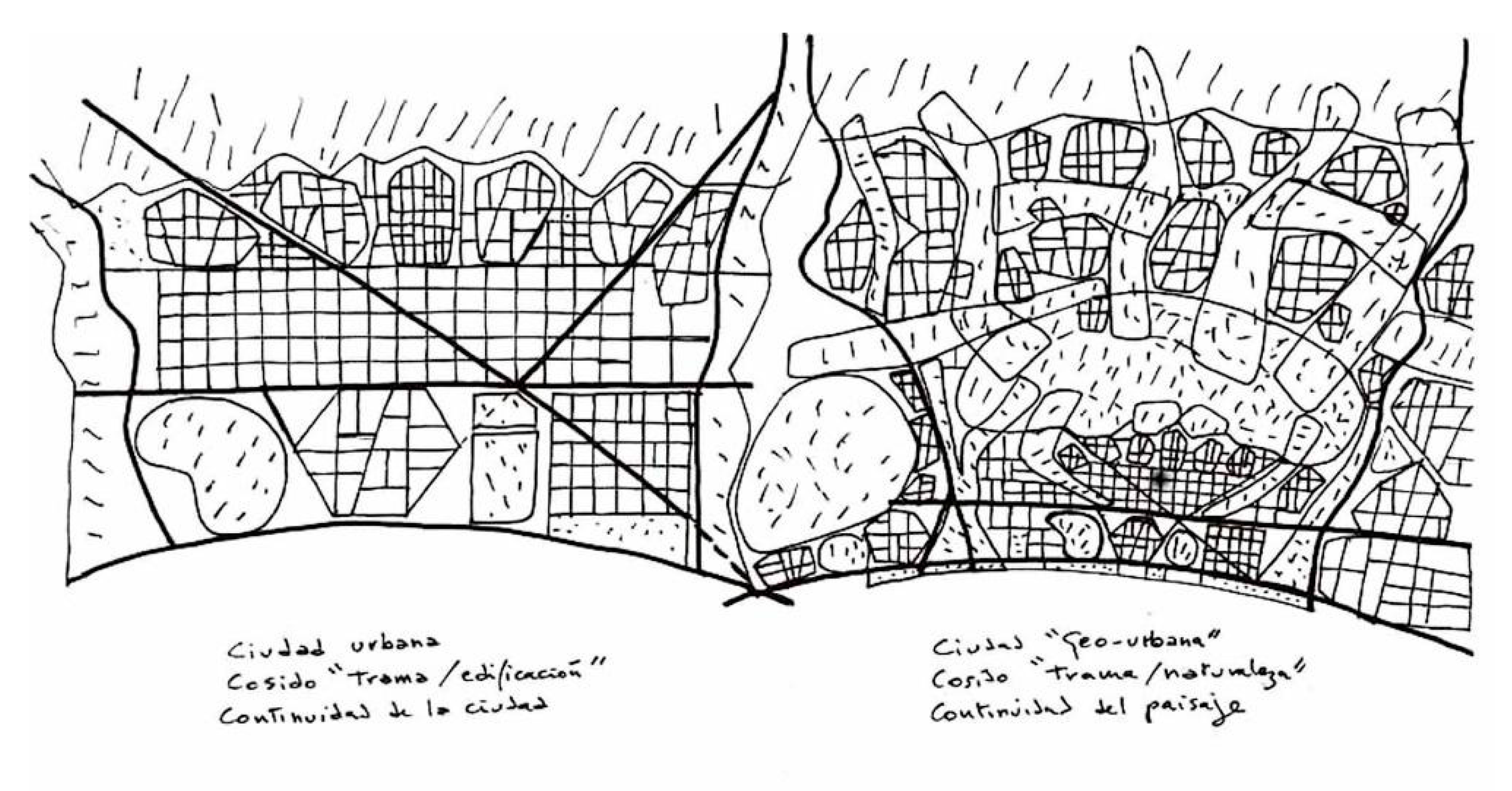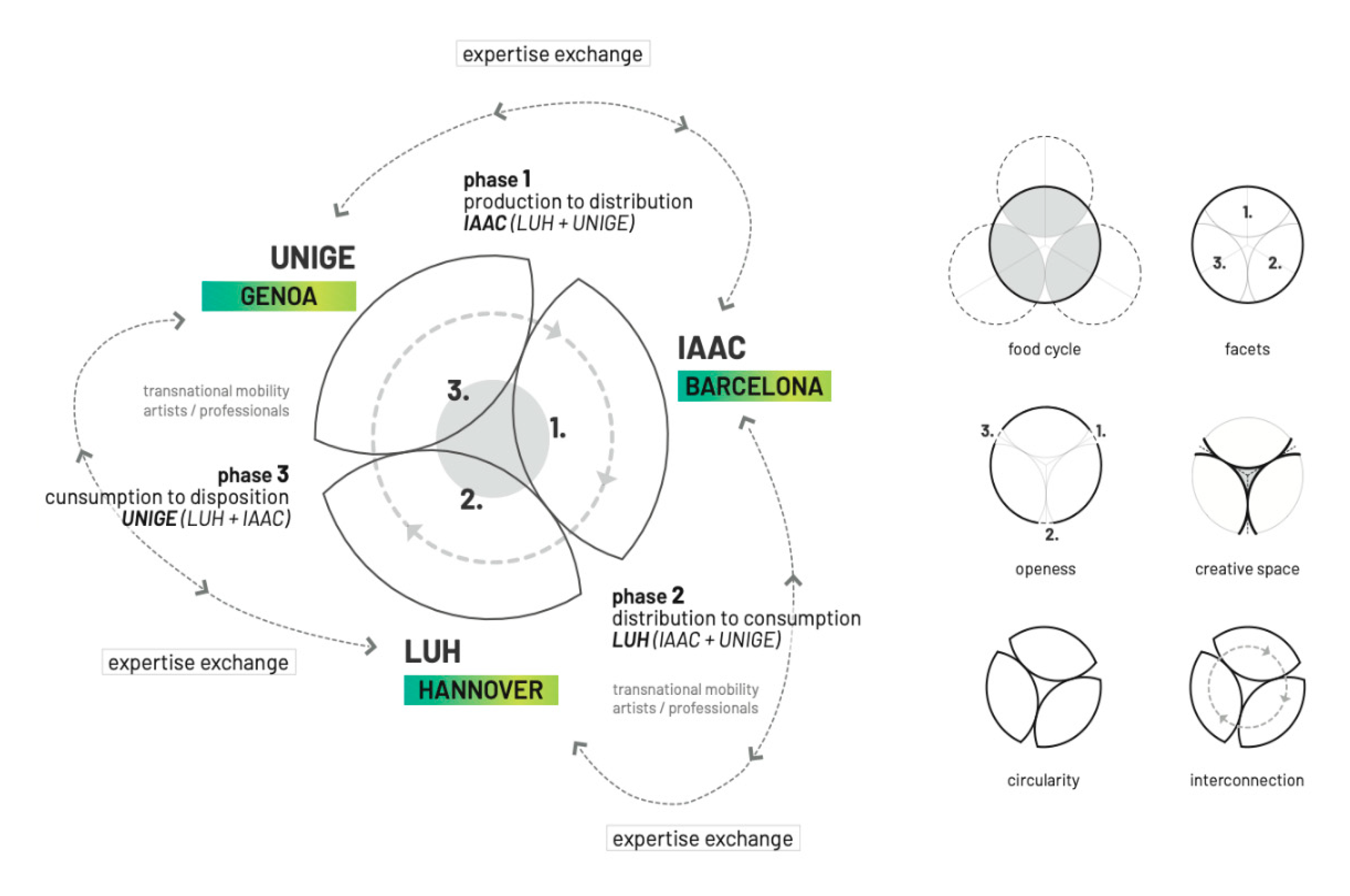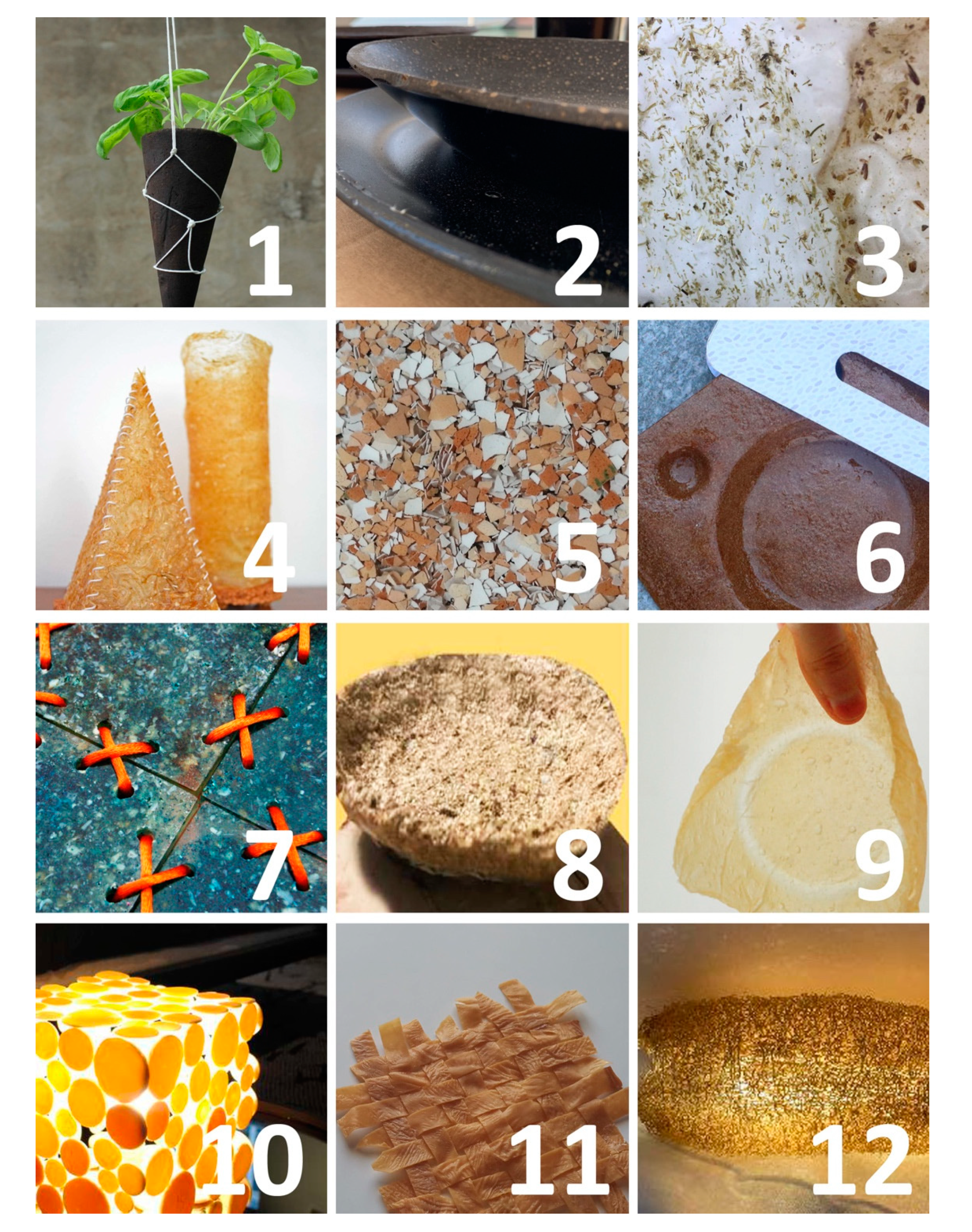Creative Food Cycles: A Cultural Approach to the Food Life-Cycles in Cities
Abstract
:1. Introduction
1.1. Land Links: Fractal Multi-Cities, Meshed Territories, and Operational Landscapes
1.2. Agro-Cultures, Agro-Cities: Potential for New “Rurban” Proactive Development
2. Methodology
2.1. Urban Cultural Revolution in the CFC
2.2. Tools
- -
- The development of three art installations in Hannover, Barcelona, and Genoa aimed at connecting professionals and citizens with creatives through the co-production of art installations and place-making laboratories;
- -
- Itinerant exhibitions on best practices and learned experiences held in Barcelona, Ljubljana, and Genoa;
- -
- An international symposium to present the project’s results to selected international representatives (experts and creatives); and
- -
- An international festival, aimed to explore, through prototypes, art installations, and art performances, the process that brings food from consumption to disposal, by offering new potential meanings and spatial combinations in design reinterpretation.
2.3. CFC Activities, Impact, and Network Dissemination
3. Results
3.1. The Consumption to Disposal Phase
3.2. Outputs
4. Main Findings
Author Contributions
Funding
Conflicts of Interest
References
- Muñoz, F. Urbanalización; Gustavo Gili: Barcelona, Spain, 2008. [Google Scholar]
- Gausa, M. Multi-Barcelona, Hiper-Catalunya. Estrategias Para Una Nueva Geo-Urbanidad; ListLab: Trento, Italy, 2010. [Google Scholar]
- Ricci, M. Nuovi Paradigmi; ListLab: Trento, Italy, 2012. [Google Scholar]
- Fabian, L.; Munarin, S. Re-Cycle Italy, Atlante; Lettera Ventidue: Siracusa, Italy, 2017. [Google Scholar]
- Carta, M.; Lino, B.; Ronsivalle, D. Re-Cyclical Urbanism; ListLab: Trento, Spain, 2017. [Google Scholar]
- Gausa, M.; Guallart, V.; Muller, W. Hipercatalunya, Territories of Research; Actar Publishers: Barcelona, Spain, 2004; pp. 1–704. [Google Scholar]
- Asher, F. Métapolis Ou L’Avenir Des Villes; Éditions Odile Jacob: Paris, France, 2010. [Google Scholar]
- Puig Ventosa, I. Polítiques Econòmiques Locals Per Avançar Cap a Formes Més Sostenibles D’habitatge I D’ocupació. In Cap A Un Habitatge Sostenible; A.A.V.V., Cads, Consell Assessor Per El Desenvolupament Sostenible, Generalitat De Catalunya: Barcelona, Spain, 2011. [Google Scholar]
- Gausa, M.; Ricci, M. Aum 01, Atlante Urbano Mediterraneo, Med.Net.It.1.0 Ricerche Urbane Innovative Nei Territori Della Costa Italiana; ListLab: Trento, Italy, 2014. [Google Scholar]
- Gausa, M. Open. Espacio-Tiempo-Información; Actar Publishers: Barcelona, Spain, 2010. [Google Scholar]
- Nel.Lo, o. Ciutat De Ciutats, Reflexió Sobre El Procés D’Urbanització a Catalunya; Empúries Editorial: Barcelona, Spain, 2011. [Google Scholar]
- Llop, C. Paisatges Metropolitans: Policentrisme, Dilatacions, Multiperifèries i Micro Perifèries del Paisatge Clixé al Paisatge Calidoscopi. Papers: Regió Metropolitana De Barcelona 2008, 47, 8–13. [Google Scholar]
- Deleuze, G.; Guattari, F. Mille Plateaux; Éditions De Minuit: Paris, France, 1980. [Google Scholar]
- Guallart, V. The Self-Sufficient City; Actar Publishers: New York, NY, USA, 2014. [Google Scholar]
- Gausa, M.; Canessa, N.; Tucci, G. Agri-Cultures, Agro-Cities, Eco-Productive Landscapes; Actar Publishers: Barcelona, Spain, 2018. [Google Scholar]
- Ministerio De Agricultura, Pesca y Alimentación/Nipo: 251-06-115-0. 2006. Hechos Y Cifras De La Agricultura, La Pesca Y La Alimentación En España. Available online: https://www.mapa.gob.es/es/desarrollo-rural/temas/programas-ue/00_tcm30-84598.pdf (accessed on 7 December 2019).
- Buonanno, D. Nuovi Paesaggi, interventi di rinaturalizzazione Urbana. Planum 2012, 2, 76–78. [Google Scholar]
- Sommariva, E. Cr(Eat)Ing City. Agricoltura Urbana. Strategie Per La Città Resiliente; ListLab: Trento, Italy, 2015. [Google Scholar]
- Carrabba, P.; Di Giovanni, B.; Iannetta, M.; Padovani, L.M. Città E Ambiente Agricolo: Iniziative Di Sostenibilità Verso Una Smart City. Eai Energ. Ambient. Innov. 2013, 21–26. [Google Scholar] [CrossRef]
- Gausa, M. City Sense: Territorializing Information. In City Sense, 4th Advanced Architecture Contest; A.A.V.V. Actar Publishers: Barcelona, Spain, 2012; pp. 6–13. [Google Scholar]
- Ratti, C. City of Tomorrow (The Future Series); Yale University Press: New Haven, CT, USA, 2016. [Google Scholar]
- Tucci, G. Albenga GlassCity. From the Glass City to the GreenCity; ListLab: Roma, Italy, 2016. [Google Scholar]
- Tucci, G. Resili(g)ence and Agro-Urban Approach, from the global framework to the Genovese Dimension. In Resili(G)Ence: Goa Resili(G)Ent City; Canessa, N., Ed.; Actar Publishers: Barcelona, Spain, 2020. [Google Scholar]
- Gausa, M. Resili(G)Ence, Intelligent Cities, Resilient Landscapes; Actar Publishers: Barcelona, Spain, 2020. [Google Scholar]
- Pothukuchi, K.; Kaufman, J. The Food System: A Stranger to the Planning Field. J. Am. Plan. Assoc. 2000, 66, 113–124. [Google Scholar] [CrossRef]
- Fassi, D.; Sedini, C. Design Actions with Resilient Local Communities: Goals, Drivers and Tools. Strateg. Design Res. J. 2017, 10, 36–46. [Google Scholar] [CrossRef] [Green Version]
- Di Lucchio, L. Design to feed the world. Diid Design 2010, 46–47, 140–152. [Google Scholar]
- Stenmarck, Å.; Jensen, C.; Quested, T.; Moates, G.; Buksti, M.; Cseh, B.; Jull, S.; Parr, A.; Politano, A.; Redlingshöfer, B.; et al. Estimates of European Food Waste Levels; Fusions: Stockholm, Sweden, 2016. [Google Scholar]
- BCFN; Fixing Food 2018. Best Practices Towards the Sustainable Development Goals. The Economist. Intelligence Unit. 2018. Available online: https://www.barillacfn.com/it/magazine/cibo-e-sostenibilita/chef-e-aziende-in-prima-linea-contro-lo-spreco-alimentare/ (accessed on 14 February 2020).
- Brown, T. Change by Design: How Design Thinking Transforms Organizations and Inspires Innovation; Harper Business: New York, NY, USA, 2009. [Google Scholar]
- Mau, B.; Leonard, J. Massive Change; Phaidon: London, UK, 2004. [Google Scholar]
- Manzini, E. Design, When Everybody Designs: An Introduction to Design for Social Innovation; Design Thinking, Design Theory; The MIT Press: Cambridge, MA, USA; London, UK, 2015. [Google Scholar]
- Wunderlich, S.M.; Martinez, N.M. Conserving natural resources through food loss reduction: Production and consumption stages of food supply chain. Int. Soil Water Conserv. Res. 2018, 6, 331–339. [Google Scholar] [CrossRef]
- Antonelli, P.; Tannir, A. Triennale di Milano. Broken Nature; La Triennale di Milano Electa: Milano, Italy, 2019. [Google Scholar]
- Ellen MacArthur Foundation. Cities and Circular Economy for Food. 2019. Available online: https://www.ellenmacarthurfoundation.org/assets/downloads/Cities-and-Circular-Economy-for-Food_280119.pdf (accessed on 14 February 2020).
- McDonough, W.; Braungart, M. Design for the Triple Top Line: New Tools for Sustainable Commerce. Corp. Environ. Strategy 2002, 9, 251–258. [Google Scholar] [CrossRef]
- Papanek, V. Design for the Real World: Human Ecology and Social Change; Thames & Hudson: London, UK, 2019. [Google Scholar]
- Fry, T. Design as Politics; Berg Publishers Ltd.: Oxford, UK, 2010. [Google Scholar]
- Cockrall-King, J. Food and City: Urban Agriculture and New Food Revolution; Prometheus Book: New York, NY, USA, 2012. [Google Scholar]




| Activity ID | Type of Activity | Activity Description |
|---|---|---|
| A | Call for the Food Interactions Catalogue | The Call for the Food Interactions Catalogue was spread via social networks and mailing lists and asked the participants to send realized projects related to three types of classification: typological, readiness, and performance categories. https://creativefoodcycles.org/food-interactions-catalogue/ |
| B1 | Creative Urban Farming Workshop, Barcelona, IAAC | The Creative Urban Farming Workshop, Barcelona, 4–6 May 2019, was aimed at developing innovative urban food production system prototypes. Each participant group made one 1:1 scale prototype for food production in the urban environment. The event involved 59 participants/creatives. https://creativefoodcycles.org/workshops/workshop-barcelona/ |
| B2 | Food Cycles Pop-Up Workshop, Hannover, LUH | The Food Cycles Pop-Up Workshop, Hannover, 23–25 May 2019, was about new models of distributing, marketing, and consuming food, as well as cooking, displaying, crafting, and sharing, in a collective “urban food hotspot.” Workshop participants learned about how to conceive and effectively communicate innovative concepts for pop-up market prototypes based on instant urban design principles. The workshop involved 66 participants/creatives. https://creativefoodcycles.org/workshops/workshop-hannover/ |
| B3 | Food Shakers | Food Remakers Workshop, Genoa, UNIGE | Food Shakers | Food Remakers Workshop, Genoa, 17–21 June 2019, was about food waste as new material, from organic food waste to the creation of new industrial materials, or food waste and packaging for new products, from organic food waste to real products for consumers. Workshop participants had the opportunity to showcase the designed prototypes at the 2019 SUQ Intercultural Food, Art and Craft, and Music Festival. The event involved 49 participants/creatives, and about 5000 citizens on the closing day, and was open to the public, within the SUQ Festival. https://creativefoodcycles.org/workshops/workshop-genova/ |
| C1 | Myco-scape Installation, Barcelona, IAAC | The CFC myco-scape installation, Barcelona, 27–29 June 2019, staged a modular system supporting the growth of edible mushrooms in the urban environment, producing both food and construction materials. The installation involved citizens of different education levels and ages. More than 1200 people participated. https://creativefoodcycles.org/installations/installation-barcelona |
| C2 | PorTable Installation, Hannover, LUH | The CFC “PorTable” pop-up installation, Hannover, 15–17 October 2019, staged a modular and movable unfolding table covered by a raised cultivating bed in which culinary or wild herbs were grown. The Installation involved 63 participants/creatives and about 220 citizens. https://creativefoodcycles.org/installations/installation-hannover/ |
| C3 | Food (re)makers Installation, Genoa, UNIGE | At the food (re)makers installation, Genoa 29–31 October 2019, the prototypes designed during the Food Shakers | Food Remakers workshop were implemented through educational laboratories organized as open days during the Festival della Scienza 2019 program. The event involved 30 participants/creatives and more than 70 middle and high school students, who conducted some workshops with the creatives. https://creativefoodcycles.org/installations/installation-genova/ |
| D1 | Responsive Cities Expo, Barcelona, IAAC | The CFC itinerant exhibition was hosted on 15–27 November 2019 in Barcelona at the IAAC main exhibition hall in parallel with the work of Responsive Cities 2019 Symposium. It involved about 680 citizens. https://creativefoodcycles.org/exhibitions/cfc-exhibition-barcelona/ |
| D2 | Future Architecture Fair, Ljubljana, LUH | The CFC itinerant exhibition was hosted on 12–13 March 2020 in Ljubljana during the Future Architecture Fair, part of the Creative Exchange 2020 event, an international gathering organized by the Future Architecture Platform, involving more than 550 citizens. https://creativefoodcycles.org/exhibitions/cfc-exhibition-ljubljana/ |
| E1 | International Online Symposium, Hannover, LUH | The CFC International Online Symposium will be organized online by LUH on 17–18 September 2020. https://creativefoodcycles.org/symposium/ |
| F1 | International Festival Food interAction!, Genoa, UNIGE | The International Festival Food interAction! will be hosted on 9–11 December 2020 in an abandoned heritage building, Albergo dei Poveri, in Genoa. The aim is to explore the process that brings food from consumption to disposal by offering new potential meanings and spatial combinations in design reinterpretation. |
| Reused Food | Type of Processing | Product Description |
|---|---|---|
| Coffee grounds | Compression material | 1. Mooka is a circular product, it is a pot for planting that becomes fertilizer. Presented in a setting that offers visitors a visual and olfactory experience. |
| Coffee grounds | Bioplastic combination | 2. DishBratta line is made by mixing coffee ground and a biological resin. It consists of a set of two dishes, a dinner plate and a deep dish, a fork, a spoon, and chopsticks. |
| Chamomile infusion | Bioplastic combination | 3. BioPlastic was born from the desire to create a line of packaging for chamomiles and infusions starting from the classic internal waste of the bags once used. |
| Fennel and walnut waste | Bioplastic combination | 4. Fennut light is a lamp that combines two materials borne from food waste. |
| Eggshell, pasta, lentils, etc. | Bioplastic combination | 5. Bis Bioresina and Bis Compostable, are tableware with different uses: the first can be re-used, and the other one is single-use and biodegradable. |
| Rice husk | Bioplastic combination | 6. V.pot is a dish made from the waste of rice husk compressed in a mold with the addition of bio-resins. |
| Fish bones | Bioplastic combination | 7. BOFISH is an innovative material obtained from bone and cartilaginous waste from fish sourced locally. |
| Peanut shell | Cooking chemistry | 8. Hanging Plates from peanut shells into bowls. |
| Honey | Cooking chemistry | 9. Miellow is a honey-based bioplastic with a high resistance to water. The semi-transparency given by honey gives it a glass-like appearance. |
| Milk | Cooking chemistry | 10. Galalith is a natural plastic material manufactured by the interaction of casein and formaldehyde. It is odorless, insoluble in water, biodegradable, non-allergenic, antistatic, and inflammable. |
| Soybean | Drying and weaving | 11. S.D.S. The skin made of soybean, combined with the weaving process, makes healthy and environmentally friendly coasters and placemats. |
| Loofah | Drying and weaving | 12. The mission of the Loofah fiber is to completely reuse decayed and inedible loofah and combine the good physical properties of the loofah. |
© 2020 by the authors. Licensee MDPI, Basel, Switzerland. This article is an open access article distributed under the terms and conditions of the Creative Commons Attribution (CC BY) license (http://creativecommons.org/licenses/by/4.0/).
Share and Cite
Navarro Gausa, M.; Pericu, S.; Canessa, N.; Tucci, G. Creative Food Cycles: A Cultural Approach to the Food Life-Cycles in Cities. Sustainability 2020, 12, 6487. https://doi.org/10.3390/su12166487
Navarro Gausa M, Pericu S, Canessa N, Tucci G. Creative Food Cycles: A Cultural Approach to the Food Life-Cycles in Cities. Sustainability. 2020; 12(16):6487. https://doi.org/10.3390/su12166487
Chicago/Turabian StyleNavarro Gausa, Manuel, Silvia Pericu, Nicola Canessa, and Giorgia Tucci. 2020. "Creative Food Cycles: A Cultural Approach to the Food Life-Cycles in Cities" Sustainability 12, no. 16: 6487. https://doi.org/10.3390/su12166487
APA StyleNavarro Gausa, M., Pericu, S., Canessa, N., & Tucci, G. (2020). Creative Food Cycles: A Cultural Approach to the Food Life-Cycles in Cities. Sustainability, 12(16), 6487. https://doi.org/10.3390/su12166487







